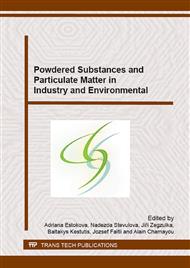[1]
S. Grangeon, F. Claret, C. Lerouge, F. Warmont, T. Sato, S. Anraku, C. Numako, Y. Linard, B. Lanson, On the nature of structural disorder in calcium silicate hydrates with a calcium/silicon ratio similar to tobermorite, Cem. Concr. Res. 52 (2013).
DOI: 10.1016/j.cemconres.2013.05.007
Google Scholar
[2]
L. Black, K. Garbev, G. Beuchle, P. Stemmermann, D. Schild, X-ray photoelectron spectroscopic investigation of nanocrystalline calcium silicate hydrates synthesised by reactive milling, Cem. Concr. Res. 36 (6) (2006) 1023-1031.
DOI: 10.1016/j.cemconres.2006.03.018
Google Scholar
[3]
G. Constantinides, F. J. Ulm, The nanogranular nature of C-S-H. J. Mech. Phys. Sol. 55 (1) (2007) 64-90.
Google Scholar
[4]
X. Zhang, W. Chang, T. Zhang, C. K. Ong, Nanostructure of calcium silicate hydrate gels in cement paste, J. Am. Ceram. Soc. 83 (10) (2000) 2600 – 2604.
DOI: 10.1111/j.1151-2916.2000.tb01595.x
Google Scholar
[5]
T. Tsutsumi, S. Nishimoto, Y. Kameshima, M. Miyake, Hydrothermal preparation of tobermorite from blast furnace slag for Cs+ and Sr2+ sorption, J. Hazard. Mat. 266 (2014) 174-181.
DOI: 10.1016/j.jhazmat.2013.12.024
Google Scholar
[6]
J. Cao, F. Liu, Q. Lin, Y. Zhang, Hydrothermal synthesis of xonotlite from carbide slag, Prog. Nat Sc. 18 (2008)1147-1153.
DOI: 10.1016/j.pnsc.2008.01.036
Google Scholar
[7]
H. Youssef, D. Ibrahim, S. Komarneni, K.J.D. Mackenzie, Synthesis of 11 Å Al-substituted tobermorite from trachyte rock by hydrothermal treatment, Ceram. Int. 36 (1) (2010) 203-209.
DOI: 10.1016/j.ceramint.2009.07.004
Google Scholar
[8]
K. Garbev, G. Beuchle, U. Scweike, D. Merz, O. Dregert, P. Stemmermann, Preparation of a novel cementitious material from hydrothermally synthesized C-S-H phases, J. Am. Ceram. Soc. 97 (2014) 2298–2307.
DOI: 10.1111/jace.12920
Google Scholar
[9]
H. G. Midgley, S. K. Chopra, Hydrothermal reactions in the lime – rich part of the system CaO – SiO2, Mag. Concr. Res. 12 (34) (1960) 19 – 26.
Google Scholar
[10]
B. V. Imlach, H. F. W. Taylor, Prolonged hydrothermal treatment of cement mixes I. Curing in water under saturated steam pressure at 140- 170 °C, Trans. Br. Ceram. Soc. 71(1972)71 – 75.
Google Scholar
[11]
T. Yano, K. Urabe, H. Ikawa, T. Teraushi, N. Ishizawa, S. Udagawa, Structure of α – Dicalcium Silicate Hydrate, Acta Cryst. 49C (1993) 1555-1559.
DOI: 10.1107/s0108270193004767
Google Scholar
[12]
K. Garbev, B. Gasharova, G. Beuchle, S. Kreisz, P. Stemmermann, First observation of α-Ca2[SiO3(OH)](OH) – Ca6[Si2O7][SiO4](OH)2 phase transformation uponthermal treatment in air, J. Am. Ceram. Soc. 91 (1) (2008) 263-271.
DOI: 10.1111/j.1551-2916.2007.02115.x
Google Scholar
[13]
K. Garbev, G. Beuchle, U. Schweike, P. Stemmermann., Hydration behavior of Celitement®: Kinetics, phase composition, microstructure and mechanical properties, in: 13th International Congress on the Chemistry of Cement, Madrid, 2011, p.159.
Google Scholar
[14]
B. Bresson, F. Meducin, H. J. Zanni, Hydration of tricalcium silicate (C3S) at high temperature and high pressure, J. Mater. Sci. 37 (2002) 5355-5365.
DOI: 10.1016/j.cemconres.2007.09.024
Google Scholar
[15]
B. Bresson, F. Meducin, H. J. Zanni, Tricalcium silicate (C3S) hydration under high pressure at ambient and high temperature (200 °C), Cem. Concr. Res. 38 (3) (2008) 320-324.
DOI: 10.1016/j.cemconres.2007.09.024
Google Scholar


